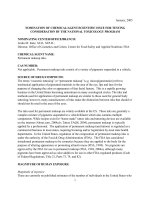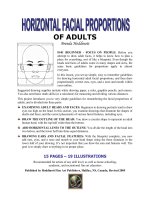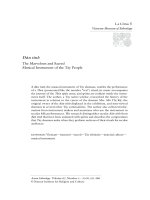Horizontal Facial Proportions of Adults
Bạn đang xem bản rút gọn của tài liệu. Xem và tải ngay bản đầy đủ của tài liệu tại đây (925.21 KB, 15 trang )
OF ADULTS
Brenda Hoddinott
H-01 BEGINNER - FOCUS ON PEOPLE: Before you
attempt to draw adult faces, it helps to know how to plan a
place for everything, sort of like a blueprint. Even though the
heads and faces of adults come in many shapes and sizes, the
same basic guidelines for proportions apply to almost
everyone.
In this lesson, you set up simple, easy to remember guidelines
for drawing horizontal adult facial proportions, and then draw
proportionally correct ears, eyes, and a nose and mouth within
your outline.
Suggested drawing supplies include white drawing paper, a ruler, graphite pencils, and erasers.
You also need basic math skills (or a calculator) for measuring and dividing various distances.
This project introduces you to very simple guidelines for remembering the facial proportions of
adults, and is divided into three parts:
EXAMINING ADULT HEADS AND FACES: Beginners to drawing portraits tend to draw
eyes too high on the head. In this section, you examine drawings that illustrate the shapes of
skulls and faces, and the correct placements of various facial features, including eyes.
DRAW THE OUTLINE OF THE HEAD: You draw a circular shape to represent an adult
human head, with the top half wider than the bottom.
ADD HORIZONTAL LINES TO THE OUTLINE: You divide the length of the head into
two halves, and the lower half into three equal distances.
DRAWING EARS AND FACIAL FEATURES: With the blueprint complete, you now
add ears, eyes, and a nose and mouth to your head shape using the three distances in the
lower half of your drawing. It’s not important that you draw the ears and features well. The
goal is to simply draw everything in its proper place.
15 PAGES – 19 ILLUSTRATIONS
Recommended for artists of any skill level, as well as home schooling,
academic, and recreational fine art educators
Published by Hoddinott Fine Art Publishers, Halifax, NS, Canada, Revised 2005
Copyright to all articles, images, text, projects, lessons and exercises within this drawing class belong to Brenda Hoddinott and may
not be reproduced or used for any commercial purposes whatsoever without the written permission of Brenda Hoddinott.
Web sites and
- 2 -
EXAMINING ADULT HEADS AND FACES
The most common mistake, made by beginners to drawing portraits, is to draw the eyes too high
on the head. However, if you look closely at an adult head, in fact you can see two halves, with
the eyes positioned on the halfway point where the two halves meet. Below are four simple
variations of the top and bottom halves of a human head. Either skull shape can be matched with
any one of the facial shapes, thereby providing many possibilities for the shapes of human heads.
ILLUSTRATION 01-01 – SKULL SHAPES
ILLUSTRATION 01-02 – FACIAL SHAPES
ILLUSTRATION 01-03 ILLUSTRATION 01-04
The shapes of human heads,
and the sizes and placements
of people’s facial features are
very different. Yet, the basic
guidelines, for rendering
accurate proportions, apply to
almost everyone.
Proportion is the relationship
in size of one component of a
drawing to another or others.
Compare the shapes of these
two adult heads to Illustrations
01-01 and 01-02.
Which skull shape is closest
to each of these two people?
Which of the basic facial shapes is closest to each?
I find the forth skull shape and the second (and first) facial shape to be close to the female head.
For the male, I think the skull shape is close to the third, and the facial shape is similar to the
forth. However, a couple of the other shapes are also close.
Copyright to all articles, images, text, projects, lessons and exercises within this drawing class belong to Brenda Hoddinott and may
not be reproduced or used for any commercial purposes whatsoever without the written permission of Brenda Hoddinott.
Web sites and
- 3 -
1) Examine each face in Illustration 01-05, and find the locations of the horizontal
halfway sections.
The eyes are halfway between the top of the skull and the bottom edge of the chin. The half
of the head above the eyes has the eyebrows, forehead and skull. Most of the face,
including the nose, mouth and chin is below the eyes.
2) Re-examine Illustrations 01-01 and 01-02, and choose a skull shape and a facial shape.
3) Sketch them joined together to make an outline of a complete head.
It’s perfectly okay to draw your skull shape (or facial shape) slightly different than in the
illustrations, such as wider, narrower, shorter or even longer.
However, don’t wander too far away from the basic shape, or your drawing may be too far
outside the parameters of what is considered normal human anatomy.
4) Turn your outline of a head-shape into an original person, by adding some facial
features and hair.
ILLUSTRATION 01-05
Keep in mind that the basic fundamentals of facial proportions are the same for everyone, despite
the diversity of human faces.
Various factors determine the physical appearances of adult faces, such as the size, shape, and
placement of features, physical development and age, differences in skeletal structures, diversity
of ethnic origin, environmental factors, diet, gender, and lifestyle. When examined closely, even
identical twins often have subtle differences in their faces.
5) Have fun creating different people by mixing and matching other skulls and faces,
and then adding facial features.
DRAW THE OUTLINE OF THE HEAD
Take the phone off the hook, find your drawing paper, let the dog in, sharpen your pencil and
find your ruler! Use good quality white drawing paper in case you need to erase. An HB pencil
worked well for me, but you can use whatever pencil you prefer.
Copyright to all articles, images, text, projects, lessons and exercises within this drawing class belong to Brenda Hoddinott and may
not be reproduced or used for any commercial purposes whatsoever without the written permission of Brenda Hoddinott.
Web sites and
- 4 -
Remember; the suggestions for the proper placement of adult facial features in this lesson are not
“rules”. Most human heads and the placements of features will follow these guidelines, but,
always keep in mind that there may be exceptions.
6) Use a ruler to draw a rectangular drawing format on your drawing paper.
Drawing format (sometimes called a drawing space) refers to the area of a drawing surface
within a specific perimeter, outlined by a shape of any size, such as a square, rectangle or
circle. Suggested sizes include 5 by 7 inches, 6 by 8 inches, or 7 by 9 inches.
7) Draw a very light line of symmetry down the center of the rectangle.
Measure and mark a small dot at the halfway point of the top and bottom sides of your
rectangle. Use a ruler to connect the two dots. This line helps keep your head shape
symmetrical and is a guide for measuring the placement of facial features.
Symmetry in drawing is a balanced arrangement of lines and shapes, on opposite sides of an
often-imaginary centerline. In the scans of my drawing throughout this project, the line of
symmetry is too light to see.
ILLUSTRATION 01-06
8) Draw a circular shape
to represent an adult
human head, with the
top half wider than the
bottom.
The basic outline of an
adult head is similar in
shape to an egg.
The line of symmetry you
drew down the center of
your rectangle, is helpful
for measuring distances
on either side, to make
sure the head in your
drawing is symmetrical.
To find out
more about drawing with a
line of symmetry, refer to
B-03 Simple Symmetry in
B-level Beginner: Learn to
See.
Copyright to all articles, images, text, projects, lessons and exercises within this drawing class belong to Brenda Hoddinott and may
not be reproduced or used for any commercial purposes whatsoever without the written permission of Brenda Hoddinott.
Web sites and
- 5 -
ADD HORIZONTAL LINES TO THE OUTLINE
In this section, you divide the length of the head into two halves. Then the lower half will be
divided into three equal distances.
ILLUSTRATION 01-07
In time you will be able to
judge all proportions visually, but for
now please use a ruler.
9) Draw a horizontal line that touches
the edge of the very top of the head.
This line is parallel to the top and
bottom of the rectangular drawing
surface (and vertical to its sides).
10) Mark this line IJ.
11) Draw a second horizontal line
touching the lower edge of the chin.
12) Mark this line GH.
ILLUSTRATION 01-08
13) Measure the total vertical distance
along the center vertical line (too light
to see in my drawing), from the top of
the head to the bottom of the chin.
14) Divide this total measurement in half
and mark it with a small dot.
Feel free to use a calculator!
15) Draw a horizontal line (AB) through
this dot, dividing the head into two
halves (as in Illustration 01-08).
Most people’s eyes and the top sections
of their ears are somewhere along this
line, halfway between the top of the
skull (not the top of the hair) and the
bottom edge of the chin.
Copyright to all articles, images, text, projects, lessons and exercises within this drawing class belong to Brenda Hoddinott and may
not be reproduced or used for any commercial purposes whatsoever without the written permission of Brenda Hoddinott.
Web sites and
- 6 -
ILLUSTRATION 01-09
16) Measure the vertical distance between
lines AB and GH.
17) Divide this distance by three and
lightly mark the two points with dots
on the center vertical line (too light to
see in my drawing).
18) Add a fourth horizontal line through
the upper point (closer to AB).
This line is parallel to each of the other
three lines, IJ, AB, and GH.
19) Mark this line CD.
The lower part of the nose and the lower
sections of the ears touch this line.
ILLUSTRATION 01-10
20) Add a fifth horizontal line
through the lower point (closer
to GH).
This line is parallel to each of the
other four lines.
21) Mark this line EF.
The lower edge of the bottom lip
will be close to or touch this line.
Now the vertical distance
between lines AB and GH is
divided into three equal sections.
Artists use several
methods for establishing adult
facial proportions. I have found
this method to be accurate and
very easy to remember.









